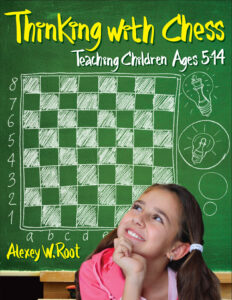Since you are a chess player, you may be asked to teach chess to others. Teaching chess can be a rewarding volunteer opportunity, as you share your love of chess with schoolchildren or with people of all ages at a library chess club. Teaching chess can also be a part-time job or a career, as many parents pay for chess instruction. Like paying for music lessons or for participation in organized sports, paying for chess lessons is routine for many families. In this article and in my next article, I share lesson plans for five 1.5 hour sessions with a mixed group (beginners through those who already know the rules of chess). Today’s article outlines my first two sessions.
From June 4-8, 2018, I taught chess at MOSAIC, run by the Coppell Gifted Association. Children entering grades 4-8 this coming fall (approximately ages 8-13) chose two 1.5-hour-long classes to fill their 9:00 a.m. to noon morning. Chess was one of the choices. Among the more than 20 other class choices were Ceramics, “Chopped” (a cooking class), and Coding. I taught chess to a group of 10 children from 9:00 a.m. to 10:30 a.m. and then taught a different group of 10 children from 10:30 a.m. to noon during the Monday through Friday week. No prior chess experience was required, so there were beginners in the classes. However, there were also children who had prior chess experience. The following lesson plans accommodated both groups.

On Monday, I began with the Classify challenge from Thinking With Chess: Teaching Children Ages 5-14. In this challenge, children sort a set of chessmen in a way that makes sense to them, then explain how they sorted to their partners. They also introduce themselves to their partners. As I observed each pair sorting and explaining, I learned who already knew the names of the chessmen and who was sorting by shapes/sizes instead. Then I asked for volunteers to show, on the demonstration board, how each chessman moves and captures. As each volunteer presented, he or she also introduced themselves to the class. Thus, the children met their partners and also learned the names of the volunteer presenters. If a volunteer presenter made a mistake in describing the chessman’s moves or left out a rule, I corrected or added to their presentation. Then I taught the two-rook checkmate lesson plan, from Children and Chess: A Guide for Educators. Children practiced the two-rook checkmate with partners, then took turns getting tested on that checkmate with me. Throughout the week, I tested on that checkmate and other basic checkmates and endings (such as king and pawn versus king), in a similar order to those listed by Elliott Neff. My exact order of drills is in my book People Places Checkmates: Teaching Social Studies With Chess. If a child successfully tested on the two-rook checkmate drill, I taught that child the one-queen checkmate drill to practice for his or her next test with me. For the last half hour of the 1.5-hour-long class, I paired the children for round 1 of a four-round Swiss system tournament. Since some players were still learning the rules, I heard their opponents correcting illegal moves or calling me over to clarify. The games were touch move, but sometimes a different chessman had to be selected if the touched chessman could not legally move. As taught in Science, Math, Checkmate: 32 Chess Activities for Inquiry and Problem Solving, children made diagrams for games that had to be adjourned for the next class. At dismissal time, I told the children to practice their drills (such as the two-rook checkmate or one-queen checkmate) at home, by viewing instructional online videos or by practicing the drills with a computer opponent or a family member.
Tuesday began with children finishing their adjourned games or practicing a drill (such as the two-rook checkmate or one-queen checkmate) or meeting with me to be tested on a drill. Then I taught “The Knights Can’t Wait!” from Science, Math, Checkmate: 32 Chess Activities for Inquiry and Problem Solving. In that lesson, children listen to a story about Coco and her grandmother then represent the story using just one white knight and one black knight. If one of my two classes finished “The Knights Can’t Wait!” early, before the half-hour set aside for Round 2 of the tournament, then I had them play a Pawn Game, test on drills, or play Battleship Chess, a game with four pawns and a king for each side and where, at the start, each side decides in secret where to place their chessmen. Battleship Chess is an original game, described in detail in Children and Chess: A Guide for Educators. The Pawn Game is in Science, Math, Checkmate: 32 Chess Activities for Inquiry and Problem Solving (but also can be found in books by other authors). Round 2 of the tournament was the last activity for the Tuesday 1.5 hour session, and the games that did not finish were adjourned.

Since I had two different groups of children in each 1.5 hour session, I repeated the above lesson plans with each group. In my next article, I will outline the lesson plans used in the next three 1.5 hour classes, on Wednesday, Thursday, and Friday of the June 4-8 week.
